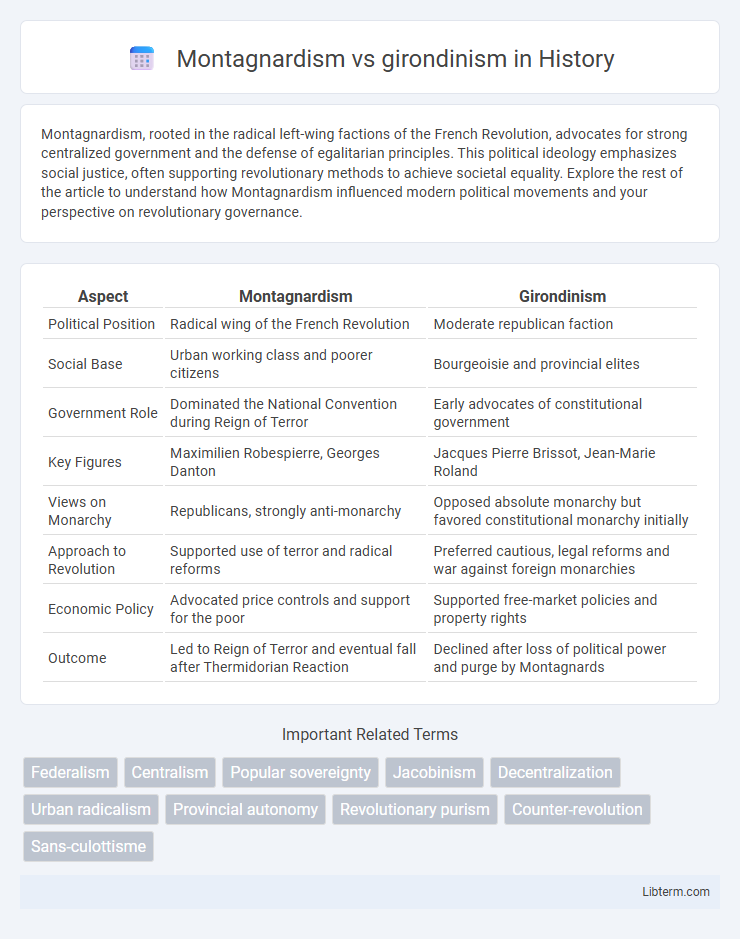Montagnardism, rooted in the radical left-wing factions of the French Revolution, advocates for strong centralized government and the defense of egalitarian principles. This political ideology emphasizes social justice, often supporting revolutionary methods to achieve societal equality. Explore the rest of the article to understand how Montagnardism influenced modern political movements and your perspective on revolutionary governance.
Table of Comparison
| Aspect | Montagnardism | Girondinism |
|---|---|---|
| Political Position | Radical wing of the French Revolution | Moderate republican faction |
| Social Base | Urban working class and poorer citizens | Bourgeoisie and provincial elites |
| Government Role | Dominated the National Convention during Reign of Terror | Early advocates of constitutional government |
| Key Figures | Maximilien Robespierre, Georges Danton | Jacques Pierre Brissot, Jean-Marie Roland |
| Views on Monarchy | Republicans, strongly anti-monarchy | Opposed absolute monarchy but favored constitutional monarchy initially |
| Approach to Revolution | Supported use of terror and radical reforms | Preferred cautious, legal reforms and war against foreign monarchies |
| Economic Policy | Advocated price controls and support for the poor | Supported free-market policies and property rights |
| Outcome | Led to Reign of Terror and eventual fall after Thermidorian Reaction | Declined after loss of political power and purge by Montagnards |
Introduction to Montagnardism and Girondinism
Montagnardism emerged during the French Revolution as a radical political faction advocating for strong centralized power and social equality, represented mainly by the Jacobins in the National Convention. Girondinism, in contrast, was characterized by moderate republicanism, favoring federalism and cautious reform, largely supported by the Girondin deputies from provinces outside Paris. The ideological clash between Montagnards and Girondins underscored the tension between revolutionary extremism and moderate constitutionalism in 1790s France.
Historical Origins of Both Movements
Montagnardism originated during the French Revolution, representing radical Jacobins who supported centralized power and social equality, mainly drawing support from Parisian working classes and sans-culottes. Girondinism emerged simultaneously as a moderate republican faction, advocating for federalism and economic liberalism, with backing primarily from provincial bourgeoisie and merchants. Both movements reflected divergent responses to the Revolution's pressures, shaping political conflicts between centralization and decentralization in late 18th-century France.
Core Ideological Principles
Montagnardism centered on radical egalitarianism, advocating for direct popular sovereignty and extensive social reforms to support the lower classes during the French Revolution. Girondinism emphasized constitutionalism, moderate republicanism, and economic liberalism, promoting federalism and the protection of individual liberties. The core ideological divide lay in Montagnards' push for centralized revolutionary authority and social equality versus Girondins' defense of decentralization and cautious political change.
Key Figures: Montagnards vs Girondins
Montagnard key figures include Maximilien Robespierre, Georges Danton, and Jean-Paul Marat, who championed radical revolutionary policies and centralized power during the French Revolution. Girondin leaders such as Jacques Pierre Brissot, Pierre Vergniaud, and Madame Roland advocated for moderate reforms, federalism, and were wary of the escalating violence. The ideological clash between these groups shaped the political landscape of the National Convention, influencing the course of the Revolution and the Reign of Terror.
Political Strategies and Tactics
Montagnardism employed radical political strategies, emphasizing centralized authority and direct action to suppress counter-revolutionaries, often using the Committee of Public Safety to enforce policies through revolutionary tribunals. Girondinism favored more moderate tactics, advocating for decentralized governance and diplomatic approaches to garner broader support for constitutional reforms. The Montagnards prioritized swift, uncompromising measures to defend the revolution, while Girondins aimed for gradual change through parliamentary debate and coalition-building.
Role During the French Revolution
Montagnardism played a crucial role during the French Revolution by advocating for radical social and political reforms and supporting the Reign of Terror to consolidate revolutionary ideals. Girondinism represented a more moderate faction, emphasizing federalism and opposing the extreme measures of the Montagnards, ultimately leading to their political decline. The conflict between Montagnards and Girondins significantly shaped the revolutionary government's policies and the trajectory of the French Republic.
Social Base and Supporters
Montagnardism drew strong support from the urban working class, radical sans-culottes, and artisans, emphasizing direct action and social equality during the French Revolution. Girondinism was backed primarily by the provincial bourgeoisie, moderate republicans, and merchants who favored decentralized government and cautious reforms. The Montagnards' base in Paris contrasted sharply with the Girondins' broader provincial middle-class supporters.
Major Conflicts and Confrontations
Montagnardism clashed with Girondinism over centralization versus federalism during the French Revolution, with the Montagnards advocating for radical, centralized control and the Girondins supporting regional autonomy. Major confrontations culminated in the fall of the Girondins in 1793, fueled by disputes over the execution of King Louis XVI and policies on war and economic reform. These conflicts intensified the Jacobin-led Reign of Terror, marking a critical turning point in revolutionary power struggles.
Impacts on Revolutionary France
Montagnardism championed radical social and political reforms, leading to the Reign of Terror and centralization of power under the Committee of Public Safety, which intensified revolutionary changes in France. Girondinism advocated for moderate republicanism and federalism, promoting decentralized governance and protecting provincial interests, which conflicted with Montagnard centralization efforts. The clash between Montagnards and Girondins shaped the trajectory of the French Revolution by influencing the balance between radicalism and moderation, ultimately determining the revolution's intensity and scope.
Legacy and Modern Interpretations
Montagnardism is historically associated with radical revolutionary ideals, emphasizing centralization and social equality, influencing modern leftist movements advocating for strong state intervention. Girondinism, favoring moderate republicanism and federalism, inspires contemporary political discourse around decentralization and liberal democracy. Both legacies shape current debates on governance, reflecting tensions between authoritarianism and pluralism in modern political theory.
Montagnardism Infographic

 libterm.com
libterm.com